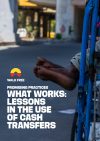Promising Practices
What works: Lessons in the use of cash transfers
This policy paper examines the success of conditional (CCT) and non-conditional cash transfers (NCT) in reducing the risk of modern slavery, including child and forced marriage, or the worst forms of child labour. For many vulnerable families, there is no real choice between sending a child to school or putting the child to work or marrying them early to help lessen the economic burden on the family. Conditional or non-conditional cash transfers can be used as a tool to empower and protect these vulnerable individuals, households, and other groups from shocks and to mitigate vulnerabilities, such as low and variable income.
This analysis is based on a set of evaluations (n=16) catalogued in the Promising Practices Database. The paper presents our observations on which practices work, which look promising, and which are ineffective. Despite some promising results, especially where cash transfers are implemented as part of a holistic program over a longer period, our analysis shows that moving this practice from ‘promising’ to ‘proven’ will require more thoughtful program design, better attention to target populations and context, and higher quality evaluations of these programs.
Standout findings
Lack of knowledge on NCTs
Though CCTs have been more popular among stakeholders, NCTs may in fact be more effective in inciting genuine behavioural change. While our knowledge pool on NCTs is too small in our Database to draw definite conclusions, policy makers should be careful not to overlook NCTs as an option when designing anti-slavery programs.
More impact through longer and earlier programs
Extending participant’s exposure to programs may be beneficial for long-term results from cash transfer interventions. Programs which ran for longer were considered more likely to have lasting effects on the rate of child marriage or child labour. Given children’s ability to adopt new behaviours and ideas, programs targeting children should be implemented earlier to have a tangible impact.
Geographic spread of non-conditional, conditional, and mixed cash transfer programs

Cash transfers are not effective in isolation
Both CCTs and NCTs must go beyond providing financial incentives to effect real and lasting change. This could include awareness raising programs at community level to shift cultural attitudes towards the worst forms of child labour and child marriage, providing skills-based training, or providing families with the resources to send their children to school.
We need to embed program evaluations
Whether cash transfer programs are effective in the long-term remains an open question as few programs across either cash transfer method conducted randomised control trials (RCTs). Going forward, those designing and implementing CCT and NCT programming should prioritise collecting robust baseline data and conducting post-assessment and long-term follow up.
Policy papers
This policy paper is the first in a series of papers stepping out lessons learned in program design as part of the Promising Projects project. Through creating a searchable database of anti-slavery and counter-trafficking programs, stakeholders can quickly understand what works, and what doesn’t.
Read our policy paper on survivor inclusion.


